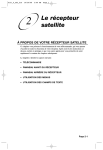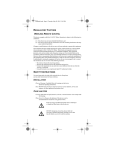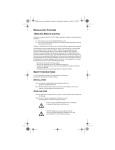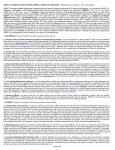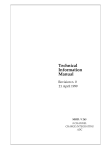Download Chapter 3 - DBSInstall.com
Transcript
Chapter 3 Using the System Using the Remote Controls The following section describes how to use the remote controls with your satellite receiver. The remote control must be in SAT mode for the buttons to control the satellite receiver. You can also use the remote to control your VCR and other devices. See Control Other Devices with the Remote on page 65. SAT Mode Button Press the SAT mode button to set the remote to SAT mode, to control the receiver. The SAT mode button’s back light turns ON briefly to show that the remote is set to SAT mode. Tip: Remote Control 1 is used to control TV1 menus on the nearby TV. Remote Control 2 is used to control TV2 menus on the remote TV(s). Power Buttons Press the blank POWER button to turn the TV1 or TV2 (depending on which remote is being used) ON or OFF. Press the TV POWER button to turn the TV on or off. Note: You must program the remote to control your TV for the TV POWER button to work as described. See page 65 for instructions. Menu Button Press the MENU button to open the Main Menu. Page Up and Page Down (Arrow) Buttons Press the PAGE UP button or the PAGE DOWN button to move, page by page, through the Program Guide, a Theme list, a Favorites List, an Event Timers list, or a list of channels. Page 31 Chapter 3 Using the System Mute Button Press the MUTE button to turn off the TV sound. Press it again to restore the TV sound. Note: You must program the remote to control your TV for the MUTE button to work as described. See page 65 for instructions. Volume Button Press the minus (-) side of the VOLUME button to lower the TV volume. Press the plus (+) side of the VOLUME button to raise the TV volume. Note: You must program the remote to control your TV for the VOLUME button to work as described. See page 65 for instructions. Guide Button Press the GUIDE button to open the Program Guide. When the Program Guide is open, press this button to switch among Favorites Lists. Arrow Buttons • • Open the Browse Banner - Press the RIGHT ARROW button. • Show Themes - Press the LEFT ARROW button. • Page 32 Change channels - Press the UP or DOWN ARROW button to change channels. Move around within the Program Guide, menus, and Browse Banner Press the UP, DOWN, LEFT, and RIGHT ARROW buttons. Using the Remote Controls TV/Video Button If you connect the receiver using its back panel TV ANTENNA/CABLE IN and CHANNEL 3–4 connections, use this button to switch the receiver CHANNEL 3–4 output between the satellite programming and another video signal such as cable or broadcast TV antenna connected to the receiver’s TV ANTENNA/CABLE IN. Select Button Press the SELECT button to select the option you highlight in a menu. Recall Button Press the RECALL button to go back to the last satellite receiver channel you were watching. Press it again to switch between the last two satellite receiver channels you were watching. Info Button • • Program information - Press the INFO button for more information when you watch a program, or when you have the Program Guide, Browse Banner, or Themes list open. Help - Press the INFO button to see help information when a Help button appears in a menu. View TV Button Press the VIEW TV button to close all menus and go to watching programming. Press the VIEW TV button to briefly display the Program Banner while watching a program. Cancel Button Press the CANCEL button to cancel and go back to the previous menu or to watch a program. Page 33 Chapter 3 Using the System Sys Info Button Press the SYS INFO button to display the System Info screen. Dish Button Press the DISH button to go to Dish Home. Number Pad Buttons When watching a program or with the Program Guide open, use these buttons to enter a channel number to change to that channel. • • • When the Program Guide is open, you can skip ahead and then back a number of hours. Just enter the number you want to skip ahead (or back), and then press the RIGHT (or LEFT) ARROW button. Use these buttons to enter menu option numbers instead of highlighting the option and then pressing the SELECT button. Use these buttons to enter numbers in a menu: • • • Highlight the place where you want to enter the first number, and press the appropriate number buttons on the remote. Use the LEFT or RIGHT ARROW button to move the highlight to the next place where you want to enter a number. When you are done entering numbers, press SELECT. Use the letters above the NUMBER PAD buttons while in the Search menu. For example, when looking for the channel and times to watch Rudy Fremmel Presents, you press 7 three times for an R, 8 two times for a U, 3 one time for a D, and 9 three times for a Y to spell the word “Rudy” (see Using Themes and Search on page 53). Star Button Press the STAR button to back space while using the search function of your receiver. Page 34 Using the Remote Controls Zero Button Press the ZERO button to forward space while using the search function of your receiver. Pound Button Press the POUND button to display the Search screen. Also, you use this button in several procedures in this User’s Guide. Recover Button Press the RECOVER button if you accidentally change the channel or video input on your TV and cannot get the picture back from your satellite receiver. When you press the RECOVER button as described below, the remote control sends commands to your TV to change channels or video inputs to try to get you back to watching satellite programming. This procedure works only if you have accidentally changed the TV channel or video input. It does not recover lost satellite signal (See Chapter 5 Reference for troubleshooting information). RECOVER only works if the remote control has been set up to control the TV and/or VCR, if connected (see page 65). Note: RECOVER will first try to tune your TV to channel 3, then channel 4, and then other video inputs with each press of the RECOVER button. You may need to press the RECOVER button up to 30 times to recover your satellite TV video. 1. Press and hold the RECOVER button until all four mode buttons light, and then let go of the button. The SAT mode button flashes twice and then all four mode buttons flash three times. 2. Press the RECOVER button. Wait for the TV mode button to flash once and then all four mode buttons to flash once. 3. If you see the System Info screen, press the SELECT button to close the screen. You have recovered your satellite video. 4. If you do not see the System Info screen, repeat steps 2 and 3 until you have recovered your satellite video. Note: Press any remote control button other than the RECOVER button to end this procedure. Page 35 Chapter 3 Using the System Using the Menus The menus make using the receiver and selecting programs quick and easy. Use the menus to control the receiver and to use its features, such as setting locks, choosing a program, or creating a favorites list. Tip: Remote Control 1 is used to control TV1 menus on the nearby TV. Remote Control 2 is used to control TV2 menus on the remote TV(s). Open and Close Menus You can open the menus in either of two ways: • • Page 36 Press the MENU button to open the Main Menu, then open any of the other menus from the Main Menu. Use the matching buttons on the remote control: Open the Program Guide. Using the Menus When watching a program, open the Themes and Search menu. Display the Browse Banner. To close a menu and return to watching a program, press either the VIEW TV or CANCEL button. Note: If you do not do anything in a menu for several minutes, the menu automatically closes. This will discard any changes you made, and display the program you were watching. Highlighting Menu Options To highlight a menu option, use the remote control ARROW buttons to move the on-screen highlight to the menu option. When you do move the on-screen highlight, the option becomes amber. The highlight is like the one that you may have seen on a computer screen. Page 37 Chapter 3 Using the System Selecting Menu Options When you select a menu option, that option takes effect right away. You can select a menu option in either of two ways: • • If the option has a number next to it, press the number on the NUMBER PAD button that matches this number. When you use the NUMBER PAD button, you do not need to highlight the option first. Move the highlight to the menu option using the remote control ARROW buttons. Then press the remote control SELECT button. In the example above, Sports is highlighted. List of Choices in the Menus When you make a choice in a list, the receiver does not apply the change until you select the Save or OK option. If you do not want to save any changes, select the Cancel option to discard all the changes made in the menu. There are two types of lists: • • A single choice list allows you to select only one choice at a time. If you select another choice, your previous choice is deselected. A multiple choice list allows you to select more than one choice at one time. If you select another choice, your previous choice(s) stays selected. Highlighting a Choice in a Menu List Use the remote control ARROW buttons to move the highlight to the desired item in the list. The black arrows on the list show where you can move the highlight. Page 38 Changing Channels Selecting a Choice in a Menu To select a choice in a list, highlight the choice and then press the remote control SELECT button. Make sure you select the Save or OK option to save your choice. Select the Cancel or Done option to discard your choice. Canceling a Procedure To cancel a procedure, you must press the remote control CANCEL or VIEW TV button before you do the last step of the procedure. If this does not work, you must finish the procedure. You can cancel a procedure in any of three ways: • • • If you want to return to watching a program, press the remote control VIEW TV button. If you want to return to the previous menu, press the CANCEL button. Wait a few moments and the menu will close automatically, discarding any changes you have made. Changing Channels There are three ways to change channels: • Press the UP or DOWN ARROW buttons. • Use the NUMBER PAD buttons. • Press GUIDE and then select the channel from the Program Guide. • Press BROWSE and then select the channel from the Browse Banner. Using the Program Guide The on-screen Program Guide provides a complete listing of the available channels and programs. You can use the Program Guide to change channels, to see what programs are scheduled, and to buy pay per view programs. Page 39 Chapter 3 Using the System Tip: If the program is on a channel that is not part of your subscription, the channel will be in red. The Program Guide shows which Favorites List is active. If the All Chan list is active, the Program Guide shows all of the channels available from DISH Network. If the All Sub list is active, the Program Guide displays only the channels in your subscription. When another list is active, the Program Guide displays only the channels in that list. For more information, see Using Favorites Lists on page 43. The Program Guide shows programs that are on now and that are scheduled up to two days in advance. The guide does not show programs that have ended. Changing the Channel in the Program Guide Tip: When using the Program Guide, do you want to know who is in the movie you’re about to watch? Press the INFO button to find out. When you’re finished, press the CANCEL button to return to the Program Guide. Tip: Selecting a program that is not on yet will open the Timers menu. See page 46 for information on setting timers. 1. Press GUIDE to open the Program Guide. 2. Choose a channel using either of the following: • • Use the NUMBER PAD buttons to enter the channel number. The Program Guide displays a block of channels including the one that you just entered. Use the ARROW buttons to move the highlight to the channel. 3. Press the SELECT button to change to the new channel. 4. Press the CANCEL button to close the Program Guide without changing the channel. Scrolling Through the Program Guide There are two ways to scroll through the Program Guide: • • Page 40 Scroll by channel - Press the PAGE UP or PAGE DOWN button to scan, page by page, through the listing of channels. Scroll by time - Enter the number of hours that you want to skip, using the NUMBER PAD buttons. Then, press the LEFT or RIGHT ARROW button. Displaying Program Information Displaying Program Information The Program Banner The Program Banner provides information about the program you are watching. The receiver displays the Program Banner for a few seconds at the top of the TV screen every time you change the channel or press the remote control VIEW TV button. The Browse Banner You can use the Browse Banner to change channels, or to see what other programs are available without changing the program that you are watching. The receiver displays information on the program you are watching at the top and Browse Banner information at the bottom of the TV screen. Note: If the All Chan Favorite list is active, the Browse Banner displays all the channels. If the All Sub list is active, the Browse Banner displays only the channels in your subscription. If a Favorites List is active, the Browse Banner displays only the channels in that list. If you have set up the Program Guide to hide adult channels and the receiver is locked, the Browse Banner does not display such channels. Page 41 Chapter 3 Using the System Using the Browse Banner Tip: When using the Browse Banner, do you want to know when the movie you’re about to watch was made? Press the INFO button to find out. When you’re finished, press the CANCEL button to return to the Program Guide. 1. Press the BROWSE (RIGHT ARROW) button to open the Browse Banner. 2. Change the channel displayed on the Browse Banner by doing one of the following: • Enter the channel number for the program that you want, using the NUMBER PAD buttons. • Press the UP or DOWN ARROW to display the next channel. 3. Press the RIGHT ARROW button multiple times to highlight the next programs. Press the LEFT ARROW button to return to the current program. Tip: If you choose a program that is on next, you’ll see a Timers menu. See page 46 for more information. Page 42 4. Close the Browse Banner by doing one of the following: • Press the SELECT button to watch the program. • Press the VIEW TV or CANCEL button to close the Browse Banner without changing the channel. Using Favorites Lists Ordering Pay Per View Programs 1. Highlight the desired pay per view program in the Program Guide and press the SELECT button. A message like the following displays: 2. To buy the pay per view program, select the Yes option. The receiver displays a confirmation menu. Note: Once you confirm an order for a pay per view program, you cannot cancel the order and you will be billed for it. Select Yes if you want to confirm your purchase. If you do not want to purchase the pay per view program, select the No or Cancel option. Using Favorites Lists Favorites Lists are lists of your favorite channels. You can create and change the lists yourself, adding and removing channels as you wish. You can have an unlimited number of favorite channels but they must be grouped into no more than four lists. For example, one Favorites List could have 100 channels and a second list only 10. Or all four lists could have 50 channels each. • When you make a Favorites List active, the Program Guide displays only the channels in that list. Also, the receiver skips channels that are not on the list when you use the remote control UP or DOWN ARROW button to change channels. • The All Chan Favorites List contains all the channels. You cannot make any changes to the All Chan list. • The All Sub Favorites List contains all the channels in your subscription. You cannot make any changes to the All Sub list, except by changing your subscription. • Each Favorites List has a unique color in the Program Guide. You can give each list a name. When you first get the receiver, the four lists are named List 1, List 2, List 3, and List 4. The lists are empty until you add channels to them. Note: If you choose a program using Theme, the receiver tunes to the channel for that program whether or not that channel is on the active Favorites List. Page 43 Chapter 3 Using the System Creating or Changing a Favorites List You can create, add channels to, and remove channels from a Favorites List. 1. Press the MENU-8 to open Favorites. 2. Select the Favorites List that you want to create or change. Note: You cannot modify the All Chan or All Sub lists. 3. Select Modify List. 4. In the Channels list, highlight a channel you want to add to the Favorites List. 5. Press SELECT to add the highlighted channel to the Favorites List. A dot appears next to the channel. 6. Repeat steps 5 and 6 until you have added all the channels that you want. 7. To delete a channel from the Favorites Lists, select the channel in the list. The dot next to the channel disappears. 8. Select the Done option to save all changes to the Favorites List. Note: If you try to save a Favorites List with no channels, you will see an error message. Page 44 Using Favorites Lists Naming a Favorites List 1. Press MENU-8 to open Favorites. 2. Select the Favorites List that you want to change. 3. Select the Edit List Name option. Note: You cannot change the name of the All Chan or All Sub list. 4. Enter the list’s name by doing one of the following: • • • Use the virtual keyboard to type the list’s name. Use the remote control NUMBER PAD to enter the letters in the Enter List Name box. Numbers 2 through 9 have telephone-style numbers written above them. To enter an H, for example, press 4 twice because H is the second letter listed above the 4 on the NUMBER PAD. You can enter up to eight characters, including spaces. If needed, select the space option to insert a space in the name or the Back option to correct a letter. Note: A list must have at least one character. Two lists cannot have the same name. TV1 and TV2 can have lists with the same names. Note: At any time, you can select the Clear Entry option to clear the name. 5. Select the Done option to save all changes. Making a Favorites List Active If the Program Guide is open, press the GUIDE button to select the next Favorites List. Press the GUIDE button repeatedly to scan through all the available lists. Note: This works only if you have added channels to the Favorites List. If you have not created any Favorites List, pressing the GUIDE button switches the receiver between the All Chan and All Sub. Page 45 Chapter 3 Using the System Using Timers Event timers let you set up the receiver to tune in future programs and/or record them on a VCR (TV1 only). An “event” is a program, sports event, pay per view movie, or anything else on satellite TV. • • You can set an automatic event timer for a program listed with start and stop times in the Program Guide. This can be a program that comes on each day or each week. A manual event timer lets you set custom start and stop times for a timer. Note: If you want to have the Event Timer record to a VCR, you must set up the receiver to control the VCR (see page 65). Remember: Most TV programs and films are copyrighted. In some cases, copyright law may apply to private, in-home recording. Event Timer Types Reminder - Reminds you that a program is about to start. Auto-Tune - Reminds you that a program is about to start and tunes the receiver to the program when it begins. VCR - Reminds you that a program is about to start, tunes the receiver to the program when it begins, and starts your VCR. This timer is available through TV1 menus only. Note: You can record only the program to which the receiver is tuned. If you open any menu while recording a program on videotape, the menu also will be recorded. If you change the volume or press the Mute button, the volume change may be recorded — depending on how your TV and VCR are set up. If a program time changes by more than twenty-four hours, the timer will not operate. Event Timer Frequency Once Applies to a one-time program. If the program time changes, this timer operates at the new time. The receiver deletes this timer when the timer operates. Mon.-Fri. Applies to a program that is scheduled for Monday through Friday on the same channel at the same time each day. Daily Applies to a program that is scheduled for Monday through Sunday on the same channel at the same time each day. Weekly Applies to a program that is scheduled for once a week on the same channel at the same time on the same day. Before an Event Timer Operates Two minutes before an event timer operates, the receiver displays a small clock on the TV screen. This clock disappears when the program begins. While the clock is displayed, you may do either one of the following: • Page 46 Press the CANCEL button to clear the symbol from the TV screen. This does not affect the timer; it will operate. Using Timers • Press the INFO button to see more information on the event timer. If you do this, you will have the following choices: • • Select the OK or Cancel option to continue with the event timer. Select the Stop Timer or No option to stop the event timer. Note: This stops only this instance of a Mon.-Fri., Daily or Weekly timer. The timer will operate the next time it is scheduled. To stop all operations of such a timer, you must delete the timer. For a Reminder Event Timer, instead of having the option to stop the timer, you have the option to tune to the program. Setting Up an Automatic Event Timer 1. Select a future program using the Browse Banner, Themes menu or the Program Guide. One of the following Create Timer screens display: TV1 TV2 2. Select a Timer Frequency option. Notice that a mark displays in the box. 3. Select a Timer Type. The Create Timer screen shown on the left is for TV1 and has a VCR Timer Type option. This Timer Type is not available for TV2 (shown on the right). 4. Select the Create option to save the event timer. Tip: Remote Control 1 is used to control TV1 menus on the nearby TV. Remote Control 2 is used to control TV2 menus on the remote TV(s). Page 47 Chapter 3 Using the System 5. The receiver displays a timer symbol in the Program Guide. Setting Up a Manual Event Timer 1. Press the MENU button. 2. Select the Timers option. 3. Select the Create option. The receiver displays the Create a Manual Event Timer menu. 4. Select a Timer Type option. Note: VCR timers are available through TV1 menus only. 5. Select a Timer Frequency option. 6. Select a channel by doing one of the following: • • Highlight a channel using the UP or DOWN ARROW button. Then, press the SELECT button. Enter a channel number using the NUMBER PAD buttons. 7. Select the Set Date/Time option. The receiver displays the Set Date/ Time for Manual Timer menu. 8. Use the NUMBER PAD buttons to enter the Start Time (this includes selecting AM or PM) and the End Time, (this includes selecting AM or PM). 9. Use the NUMBER PAD buttons to enter the Date. 10. Select the Create Timer option. 11. To create another event timer, do one of the following: • • Select the Create option again. If you do not want to create another event timer, press the CANCEL button. Note: You cannot set a manual event timer for a pay per view event. Page 48 Using Timers Overlapping Timers If you try to create event timers for overlapping programs, the receiver displays a screen with the dates and times of both programs. The receiver also displays this screen if a program time has changed, causing one timer to overlap another. You must delete or edit one of the timers. When the Timer Conflict screen displays, resolve the conflict by doing the following: 1. Select one of the timers. The Timer Conflict Resolution screen displays. 2. When the Timer Conflict Resolution displays, select one of the following choices: • • • Delete This Timer - Removes the timer completely. Edit This Timer - You can edit the timer to resolve the conflict. Skip This Timer Once - Select this option if you are creating a timer for a special program (Once) and have a timer set for a program you watch regularly (Mon.-Fri, Daily, or Weekly). For example, you want to set a timer for an awards show (Once), but it conflicts with the timer for a news program (Mon.-Fri, Daily, or Weekly). Select the timer for the news program and then select Skip This Timer Once. 3. Select Yes to close the Timer Conflict Resolution screen. 4. Select Done. Page 49 Chapter 3 Using the System Maximum Number of Event Timers You can create a limited number of event timers. If you try to create more, the receiver displays a menu giving you the option to delete an existing timer. If you do not delete an existing timer, you will not be able to create any new ones. Reviewing and Editing Event Timers You can review and edit both automatic and manual event timers. If you need to change an event timer, you can edit almost any feature of an event timer. Note: If you edit an automatic timer, it becomes a manual timer. The manual event timer operates at the times you set, not the actual program times. 1. Press the MENU button. 2. Select the Timers option. The receiver displays the Timers menu. 3. Select the event timer that you want to edit. A mark appears in the box next to the event timer. 4. Select the Edit option. You may change the Timer Type, Timer Frequency, or Channel. To do this, select each option that you want. 5. If you want to change the Start Time, the End Time, or the Date, select the Set Date/Time option to display the Set Date/Time for Manual Timer menu. Otherwise, skip to step 9 of this procedure. 6. Use the number buttons to enter the Start Time (this includes selecting AM or PM) and the End Time (this includes selecting AM or PM). 7. Use the number pad buttons to enter the Date. 8. Select the Create Timer option. Deleting an Event Timer 1. Press the MENU button. 2. Select the Timers option. The receiver displays the Timers menu. Page 50 Using Timers 3. Select an event timer(s) that you want to delete. A check mark appears in the box next to the event timer(s). 4. Move the highlight to Delete and press SELECT on the remote. Special Considerations When Using Event Timers • • • For Locked Programs - You must enter the receiver password before you can create an automatic event timer. You can create a manual event timer for a locked program without entering the password. However, if you do this, when the event timer operates the receiver may display only an error or password entry menu. If you have set a VCR Event Timer, the VCR will record only that menu. For Pay Per View Programs - You must order a pay per view program before you can create a timer for it. For Blacked Out Programs - If you set a timer for a program that is blacked out in your area, when the event timer operates the receiver may display only an error. If you have set a VCR Event Timer, the VCR will record only that menu. Event Timer Performance when the Receiver is Off If the receiver is OFF at the time an Auto-Tune or VCR Event Timer is scheduled to operate, the receiver will turn ON. Once the event has ended, the receiver will turn OFF, unless you pressed any remote control or receiver front panel buttons during the time that the timer was active. If the receiver is OFF at the time a Reminder Event Timer is scheduled to operate, the timer will turn the receiver ON and tune it to the channel you last watched. The receiver will then display the reminder menu. You will have a few seconds to respond. If you do not respond to the reminder menu, the receiver will turn OFF. Setting Up the Receiver to Control a VCR (TV1 Menu Only) The receiver transmits an IR signal from the front panel to control the VCR. This signal is much stronger than the signal the remote uses, so it can bounce off walls or other objects on its way to the VCR. This works in most home setups. However, shelves or smoked glass doors between the receiver front and the VCR may block the signal. Also, if the signal must cross a very large room, or bounce off curtains, it may not be strong enough to control the VCR. Make sure that nothing blocks the signal, and that the signal can bounce off relatively nearby, light-colored, smooth surfaces. Note: VCR setup is only available through TV1 menus. Tip: Remote Control 1 is used to control TV1 menus on the nearby TV. Remote Control 2 is used to control TV2 menus on the remote TV(s). To set up TV1 to control a VCR, use Remote Control 1 at the nearby TV and do the following: 1. Press the MENU button. 2. Select the System Setup option. Page 51 Chapter 3 Using the System 3. Select the Installation option. 4. Select the VCR Setup option. 5. Set the VCR code by doing one of the following: • • Enter the 3-digit VCR code number, from the tables starting on page 105, using the NUMBER PAD buttons. Highlight each digit of the VCR code, and then press the UP or DOWN ARROW button until you reach the correct number and then press SELECT. 6. Make sure the VCR is connected to one of the TV1 outputs and is set to display from the TV1 output to the nearby TV. Consult your VCR user’s guide. 7. Make sure the VCR is turned on. Insert a rewound tape on which you want to record. Note: The receiver only starts and stops the VCR recording, but does not turn ON the VCR, so you must do this yourself. 8. To test the new code, highlight the Test option. The receiver displays a message warning you to make sure the VCR is turned ON. 9. Press the SELECT button to start the test. Your VCR records for a few seconds, stops, and then rewinds. The receiver displays a message saying that your VCR test is complete. Follow the instructions on the message. If your VCR did not do the test, enter another code from the table. Repeat step 8 and this step. 10. Once you have found the correct VCR code, select the Save option to save the VCR code you entered and return to the Installation and Setup menu. Page 52 Using Themes and Search Using Themes and Search The Themes and Search feature of your receiver makes it easy to find programs to watch. This menu allows you to search for programming by themes (movies, sports, etc.) or by key words used in the program information. Themes You can list and choose programs by the theme of their contents, for example, just movies or just sports. You can then quickly list programs based on that theme, and choose the program you want. 1. Open the Themes and Search menu by doing one of the following: • • While watching a program, press the LEFT ARROW button. Press the MENU button, and then select the Themes option. 2. Select the option for a category. 3. Select the desired program in the program list. Note: If the program you highlighted is on some time in the future, the receiver will open the Create An Event Timer menu. See Using Timers on page 46 for more information. Page 53 Chapter 3 Using the System Search 1. Open the Search screen by doing one of the following: • • • Press the Pound (#) button on the remote control. While watching a program, press the LEFT ARROW button to display the Themes and Search menu. Then select Search. Press the MENU button, and then select the Themes option to display the Themes and Search menu. The select Search. 2. The Search screen displays with a virtual keyboard. 3. You can search for events two ways: • • Tip: Use Search History instead of the keyboard if you’ve searched for the program or information before. Page 54 Select Title to search for the words that appear in the title of a program. Select Info to search for words that are in the program description. 4. Enter the information in that space provided in one of two ways: • • Use the virtual keyboard to type the information in the space provided. Use the letters above the NUMBER PAD buttons while in the Search menu. For example, when looking for the channel and times to watch Rudy Fremmel Presents, you press 7 three times for an R, 8 two times for a U, 3 one time for a D, and 9 three times for a Y to spell the word “Rudy.” Using Themes and Search 5. Select Search. 6. When the receiver displays the Search Results you have the following options: • • • Use the UP and DOWN ARROW buttons to scroll through the results. Use the PAGE UP and PAGE DOWN buttons to scroll a page at a time. Select Page Up or Page Down to scroll a page at a time. 7. Select one of the programs to watch, or select Done to close the Search Results screen. Note: If you select a program that is on now, the receiver tunes to that program. If you select a program that is on in the future, you will have to set a timer. See page 46 for more information on event timers. Search History After you have searched for programs or other information, your receiver builds a history. TV1 and TV2 keep separate Search History information. You can use the Search History instead of typing the information again with the virtual keyboard. 1. Press the Pound (#) button to open the Search screen. 2. Select History to display the Search History screen. Page 55 Chapter 3 Using the System 3. At the Search History screen, you have the following options: • Search - Select one of the items and then select Search. • Edit - Select one of the items and then select Edit to make changes. • Delete - Select one of the items and then select Delete. • Delete All - Select Delete All to clear the Search History. Using Locks When you unlock programming delivered by the TV2 outputs to your in-home cabling system, you are allowing all TVs connected to your in-home cabling system to have access to this programming. In this case, you must rely on the V-Chip technology and settings in the individual TVs to prevent viewing of inappropriate programming. Consult your TV user’s guides for instructions to set up V-Chip protection. Note: Locks for programming on the TV1 outputs for the nearby TV are set using the TV1 menus. Locks for programming on the TV2 outputs to remote TVs are set using the TV2 menus. The section below applies to locks set by either TV1 or TV2 menus. Locks set for TV1 programming are separate from locks set for TV2 programming. How to Set Locks: A Two Step Process 1. Create the locks that you want. 2. Lock the receiver. When the receiver is locked, anyone who wants to access locked items must enter the password. When You Have Locked the Receiver • • • • Page 56 If you try to access a locked item or open the Locks menu, the receiver displays a message prompting you to enter the password. The receiver allows you three tries to enter the correct password. If you fail to enter the correct password, the receiver does not allow more tries for several minutes. If you enter the correct password, you can access the locked item or open the Locks menu. If you exit a locked item or close the Locks menu, you must enter the password to access the item. Using Locks Locking and Unlocking the Receiver You must lock the receiver for any receiver Locks you set to take effect. To lock the receiver, you must first create a password. If you forget your password, you will need to speak with a Customer Service Representative. If you have a Personal Identification Number (PIN), you will need to give it to the Customer Service Representative. See page 62 for information on PINs. 1. Press the MENU button to display the Main Menu. 2. Select the Locks option to display the Locks menu. Note: If the receiver displays a message prompting you to enter a password, the receiver has already been locked. 3. Select the Lock System or Unlock System option. The receiver displays a message prompting you to enter a password to lock the system. 4. Enter and verify a password, using the NUMBER PAD buttons. The receiver displays stars (*) as you enter the digits of the password. 5. Memorize your password. From now on, you must enter this password to lock or unlock the receiver. 6. Select the OK option. Confirm the password by re-entering it. All the locks you have set are now in effect. Page 57 Chapter 3 Using the System Creating or Changing Rating (Content) Code Locks 1. Press the MENU button. 2. Select the Locks option. 3. If the receiver is locked, enter the password using the number pad buttons. The receiver displays stars (*) as you enter the digits of the password. As soon as you enter the fourth digit of the password, the receiver highlights the OK option. Press the SELECT button. 4. Select the Ratings Locks option. 5. Highlight the rating that corresponds to the lowest acceptable audience age. Press the SELECT button to lock the highlighted rating. Note: All ratings that are more restrictive than the selected rating are also selected. For example, if you lock PG-13 rated programs, then all programs with the R, NC-17, and NR/AO ratings are also locked. 6. Select the expanded rating code(s), if you want to also lock these ratings. 7. To unlock a rating code, highlight the code and press SELECT. 8. Select the Save option to save the changes. 9. If the receiver is not locked, you must lock it to put the locks you just created into effect. Creating or Changing Channel Locks You can lock any channel, including pay per view channels. 1. Press the Menu button. 2. Select the Locks option. 3. If the receiver is locked, enter the password using the number pad buttons. The receiver displays stars (*) as you enter the digits of the password. As soon as you enter the fourth digit of the password, the receiver highlights the OK option. Press the SELECT button. Page 58 Using Locks 4. Select the Channel Locks option. 5. Highlight the channel that you want to lock. If necessary, press the UP or DOWN ARROW button to see the channel. You can also enter each channel number using the NUMBER PAD buttons. 6. Press the SELECT button to lock or unlock the highlighted channel. If the checkbox next to the channel has a checkmark, the channel is locked. 7. Select the Save option to save the changes. 8. If the receiver is not already locked, you must lock it to put the locks you just created into effect. Locking and Unlocking the Receiver Front Panel (TV1 Only) This keeps anyone from changing the channel, but it does not lock the remote control buttons. This option is only available on TV1 menus. 1. Press the MENU button. 2. Select the Locks option. 3. If the receiver is locked, enter the password using the NUMBER PAD buttons. The receiver displays stars (*) as you enter the digits of the password. As soon as you enter the fourth digit of the password, the receiver highlights the OK option. Press the SELECT button. Tip: Remote Control 1 is used to control TV1 menus on the nearby TV. Remote Control 2 is used to control TV2 menus on the remote TV(s). 4. Select the Front Panel Lock option to lock or unlock the front panel. 5. Select the Yes option. 6. To activate the front panel lock, you must lock the receiver. Page 59 Chapter 3 Using the System Locking and Unlocking Pay Per View Channels This locks all pay per view channels. You also can lock one or more pay per view channels by using channel locks or rating locks. 1. Press the MENU button. 2. Select the Locks option. 3. If the receiver is locked, enter the password using the NUMBER PAD buttons. The receiver displays stars (*) as you enter the digits of the password. As soon as you enter the fourth digit of the password, the receiver highlights the OK option. Press the SELECT button. 4. Select the Lock PPV or Unlock PPV option. 5. If the receiver is not locked, you must lock it to put the lock you just created into effect. Hiding and Showing Adult Channels When you hide adult channels, you keep the Program Guide, Themes lists, and the Browse Banner from displaying adult channels. It also keeps anyone from choosing such channels by using the UP or DOWN ARROW buttons or the remote control NUMBER PAD buttons. 1. Press the MENU button. 2. Select the Locks option. 3. If the receiver is locked, enter the password using the NUMBER PAD buttons. The receiver displays stars (*) as you enter the digits of the password. As soon as you enter the fourth digit of the password, the receiver highlights the OK option. Press the SELECT button. Page 60 Using Locks 4. Select the Hide Adult or Show Adult option. 5. If the receiver is not locked, you must lock it to put the lock you just created into effect. Changing the Receiver Password 1. Press the MENU button. 2. Select the Locks option. If the receiver is locked, enter the password using the NUMBER PAD buttons. The receiver displays stars (*) as you enter the digits of the password. As soon as you enter the fourth digit of the password, the receiver highlights the OK option. 3. Press the SELECT button. 4. Select the Change Password option. 5. Enter the current password using the number pad buttons. As soon as you enter the fourth digit of the password, the receiver highlights the OK option. 6. Press the SELECT button. 7. Enter the new password using the number pad buttons. As soon as you enter the fourth digit of the password, the receiver highlights the OK option. Page 61 Chapter 3 Using the System 8. Select the OK option to change the password. 9. Enter the new password again for confirmation, using the NUMBER PAD buttons. The receiver displays stars (*) as you enter the digits of the password. As soon as you enter the fourth digit of the password, the receiver highlights the OK option. Press the SELECT button. 10. Memorize the new password. From now on, you must enter this password to lock or unlock the receiver. Personal Identification Number You can set up a Personal Identification Number (PIN) for call-in requests only. Anyone calling the Customer Service Center must provide this PIN to make any changes to your account. You may call the Customer Service Center at any time to set up a PIN. If you forget your PIN, you will need to speak with a Customer Service Representative. The representative may ask for more information to make sure that you are authorized to make changes to your account. Page 62 Using Caller ID Using Caller ID Caller ID displays on your TV the names of people as they call you if you subscribe to Caller ID from your local phone company. To use this feature, make sure you have a phone line connected to the receiver and that the Caller ID feature is enabled. After you turn on Caller ID, it stays on until you decide to turn it off. Caller ID Screens When you receive a call, you will see a Caller ID popup screen. You can select OK to eliminate the message. If you do nothing, it will disappear after 20 seconds. If you are in a menu when a call comes in, you will see a different Caller ID popup screen. Turning Caller ID On and Off 1. Press MENU on the Remote Control. 2. Select System Setup. 3. Select Installation. Page 63 Chapter 3 Using the System 4. Select Caller ID. 5. Select Enable Caller ID or select Disable Caller ID. 6. Select Done. Resetting the Receiver Note: Resetting the receiver discards all Favorite Lists except the All Chan and All Sub lists. Note: If you have set any locks on the receiver, and the receiver is locked, these locks will be kept. If the receiver is unlocked, any such locks will be lost. You cannot reset the receiver to default settings to discard a password you have forgotten. Nobody can reset the receiver to bypass a receiver lock. If you want to reset the receiver to be the same as when it was shipped from the factory, do the following: 1. Press the MENU button. 2. Select the System Setup option. 3. Select the Factory Defaults option. When the receiver displays a Warning message, confirm that you want to reset the receiver. 4. Select the Yes option to confirm the reset. Page 64 Changing Program Languages Changing Program Languages You may be able to change the language of some programs. An alternate language may not be available for all programs. Some programs, such as movies, show at the start whether an alternate language is available. An alternate language applies only to the audio part of a program and does not change the language used in the menus displayed by the receiver. 1. Press the MENU button. 2. Select the Preferences option. 3. Select the Alternate Audio option. 4. Select the language you want in the Languages list. 5. Select the Save option to save your language choice. The receiver displays the System Setup menu. Control Other Devices with the Remote Controls This section describes how to use Remote Control 1 or Remote Control 2 to control with a TV, a VCR, or other devices. For information on how to use the remote to control the receiver, see Using the Remote Controls on page 31. You can set up both remote controls to control the satellite TV receiver and up three other devices each. These devices can be a TV, a VCR or DVD player, and a third device. Where the word “remote” is used in the following section, it applies to both Remote Control 1 and Remote Control 2. Tip: Remote Control 1 is used to control TV1 menus on the nearby TV. Remote Control 2 is used to control TV2 menus on the remote TV(s). Page 65 Chapter 3 Using the System Remote Control Modes You can set the remote to four different modes to control the receiver or other devices. When you get the remote it’s already set up to control the receiver. You must set up the remote to control a device like a TV or a VCR. See Set Up the Remote to Control Other Devices, below. Use the remote control’s mode buttons, SAT (satellite receiver), TV (for a TV), VCR (for a VCR or a DVD player), and AUX (“auxiliary,” for a second TV, a second VCR, a tuner, or an audio amplifier) to set the remote to the right mode for the device. To change the mode, press the button for the device you want the remote to control. The mode button lights for two seconds to show you’ve set the remote to that mode. Limited Mode Tip: Limited mode is not used with amplifiers. You can program your remote control in limited mode to keep from accidentally changing the channel on your TV or VCR. When you use the remote to control your TV in limited mode, you will only be able to use the POWER, MUTE, and VOLUME buttons. Also, when you use the remote to control your VCR in limited mode, you will only be able to use the power and VCR function buttons. The section Setting Up the Remote to Control Other Devices has a step that tells the remote control to go into limited mode. Set Up the Remotes to Control Other Devices Over the next few pages we tell you how to use the remote to control a TV, a VCR, a DVD player, a tuner, or an amplifier. To use the remote to control other devices, you must first program it to control these other devices. You can do this by either following the instructions in Set Up the Remote Control below, or the Scan for Device Codes procedure described on page 67. Set Up the Remote Control 1. Turn the device on. Use the device’s front panel buttons or its remote control. 2. Find the brand name of the device in the tables starting on page 104. If the brand isn’t listed, see Scan for Device Codes on page 67. 3. Press and hold the mode button until all the other mode buttons light up, and then let go of the button. For example, hold the TV mode button for a TV until all of the other mode buttons light. When you let go, the TV mode light will flash. The mode button flashes. Page 66 Control Other Devices with the Remote Controls 4. For AUX mode only: • • • Press 0 for a second TV. Press 1 for a second VCR or DVD player. Press 2 - for a tuner or amplifier. This step is for programming which kind of device that should be programmed in AUX mode. If you’re not programming in AUX mode, skip to step 5. 5. Enter one of the three-digit device codes from the table using the number buttons. The three-digit device code should be for the brand name of your device that you found in step 2. 6. If you want to program limited mode, press 1. If not, skip to step 7. See Limited Mode for more information. 7. Press the POUND (#) button. If you entered the code correctly, the mode button flashes three times. 8. Press the blank POWER button to turn off the device. If the device does not turn off, go to step 10. If the code works, the device should turn off. 9. Turn the device back on and try some other buttons to make sure they work. If the code works for other buttons, stop here. Sometimes the blank POWER button works when other buttons don’t. 10. If the code doesn’t work, redo steps 3 through 9 with another device code from the tables. Try every code listed for you brand until one works for your device. 11. If you can’t find a code that works try Scan for Device Codes that follows. Scan for Device Codes If the code for your device is not listed in the tables starting on page 104, use this procedure to scan the remote control’s memory for the device code. 1. Turn the device on. Use the device’s front panel buttons or its remote control. 2. Press and hold the mode button until all the other mode buttons light up, and then let go of the button. For example, hold the TV mode button for a TV until all of the other mode buttons light. When you let go, the TV mode light will flash. The mode button flashes. Page 67 Chapter 3 Using the System 3. For AUX mode only. • • • Press 0 for a second TV. Press 1 for a second VCR or DVD player. Press 2 - for a tuner or amplifier. This step is for programming which kind of device that should be programmed in AUX mode. If you’re not programming in AUX mode, skip to step 4. 4. Press the blank POWER button. This puts your remote in the scan mode. 5. Press the UP or DOWN ARROW button repeatedly until the device turns off. As you press the UP or DOWN ARROW button, the remote is trying each code in the memory to see if it can turn off your device. When the device turns off, you have found a code that might work. Note: The mode button for the device will flash rapidly eight times when you’ve scanned all the codes for that device. 6. Press the POUND (#) button. This stores the code you found. 7. Turn the device back on and try some other buttons to make sure they work. Press the blank POWER button to turn the device back on. Try some other buttons to make sure they work. Sometimes, the blank POWER button works when other buttons don’t. 8. Repeat this procedure until you’ve tried all the codes. You may need to repeat the scan to find the best code for your device. Check the Device Codes Tip: Remote Control 1 is used to control TV1 menus on the nearby TV. Remote Control 2 is used to control TV2 menus on the remote TV(s). You can find out what device code you’ve set for each remote control mode. 1. Press and hold the mode button until all the other mode buttons light up, and then let go of the button. The mode button flashes. Page 68 For example, hold the TV mode button for a TV until all of the other mode buttons light. When you let go, the TV mode light will flash. Control Other Devices with the Remote Controls 2. Press the POUND (#) button twice. Watch the mode light to determine your code. The mode button flashes the number for each digit of the device code, with a pause between the groups of flashes. A quick flash is for zero. For example, if the code is 570, the mode button flashes five times, pauses, flashes seven times, pauses, and flashes once quickly. 3. For AUX mode only. The first group of flashes tells you what the AUX mode controls. A quick flash (zero) before the three-digit code is for a TV; one regular flash is for a VCR or DVD player; and two flashes is for a tuner or amplifier. For example, if the TV code is 570, the AUX mode button flashes once quickly (indicating 0 for TV), pauses, flashes five times, pauses, flashes seven times, pauses, and flashes once quickly. Remote Control Buttons Control the Receiver When you get the remote it’s already set up to control the receiver. However, you must set up the remote to control the TV before you can use the MUTE and VOLUME buttons. For information on the remote buttons that control the receiver, see Using the Remote Controls on page 31. Control a TV (or a Second TV) Only the buttons described here control a TV. Some of the buttons described here may not control your TV. Please see your TV user’s manual for information about the TV’s features. TV Mode Button You must first set up the remote to control the TV. See Set Up the Remote to Control Other Devices, beginning on page 66. Then, you must press the TV mode button to set the remote to TV mode. The TV mode button lights for two seconds to show you’ve set the remote to TV mode. Make sure you keep the remote in TV mode to use the buttons described here. Note: You can set up the remote to control a second TV in AUX mode, the same way it controls the first TV in TV mode. See Set Up the Remote to Control Devices beginning on page 66. Page 69 Chapter 3 Using the System TV/Video Button If the TV has video input options, use this button to switch the TV video input. Power Button Press the TV POWER button to turn the TV on or off. Mute Button Press the MUTE button to turn the TV sound on or off. Volume Button Press this button to raise (+) or lower (-) the TV sound volume. Up and Down Arrow Buttons Use the UP and DOWN ARROW buttons to change channels on the TV. Note: These buttons do not change the channels on the TV if the remote control is in limited mode. Select Button The SELECT button works as the ENTER button for a TV. Recall Button Press the RECALL button to go back to the last TV channel you watched. Press it again to switch between the last two TV channels you watched. Page 70 Control Other Devices with the Remote Controls Number Buttons Use the NUMBER buttons to directly enter a different channel. Note: These buttons do not change the channels on the TV if the remote control is in limited mode. Control a VCR (or a Second VCR or a DVD Player) Only the buttons described here control a VCR or DVD player. Some of the buttons described here may not control your VCR or DVD player. See the user’s manual that came with your VCR or DVD player for information about the features. VCR Mode Button You must first set up the remote to control the VCR. See Set Up the Remote to Control Devices, beginning on page 66. Then, you must press the VCR mode button to set the remote to VCR mode. The VCR mode button lights for two seconds to show you’ve set the remote to VCR mode. Make sure you keep the remote in VCR mode to use the buttons described here. Note: You can set up the remote to control a second VCR in AUX mode, the same way it controls the first VCR in VCR mode. See Set Up the Remote to Control Devices beginning on page 66. Note: You must set the remote to VCR mode to set it up to control a DVD player. Once you do this, you must set the remote to VCR mode to control a DVD player. TV/Video Button Use the TV/VIDEO button to switch the VCR between its TV mode and its VCR mode (see your VCR user’s manual for information). Power Button Press the blank POWER button to turn the VCR on or off. Page 71 Chapter 3 Using the System Mute Button Press the MUTE button to turn the TV sound off or on. Page Up and Down Arrow Buttons Use the PAGE UP and DOWN ARROW buttons to change channels on the VCR. Note: If you are using the remote control in limited mode, the VCR will not change channels. Recall Button Press the RECALL button to go back to the last VCR channel you used. Press it again to switch between the last two VCR channels you used. • • • • • • Page 72 VCR Buttons Press the LEFT ARROW button to rewind a videotape. Press the DOWN ARROW button to pause a videotape. Press this button or the PLAY button to go back to playing the tape. Press the RIGHT ARROW button to forward a videotape. Press the STOP button to stop playing or recording on a videotape. Press the RECORD button to record on a videotape. Press the SELECT button to play or to go back to playing a videotape. Control Other Devices with the Remote Controls Number Buttons Use the NUMBER buttons to enter channel numbers. Note: If you are using the remote control in limited mode, the VCR will not change channels. Control a Tuner or Amplifier Only the buttons described here control a tuner or amplifier. Some of the buttons described here may not control your tuner or amplifier. Please see the user’s manual that came with your tuner or amplifier for more information. AUX Mode Button You must first set up the remote to control the device. See Set Up the Remote to Control Devices, beginning on page 66. Then, you must press the AUX mode button to set the remote to AUX mode. The AUX mode button flashes once to show you’ve set the remote to AUX mode. Make sure you keep the remote in AUX mode to use the buttons described here. Power Button Press the blank POWER button to turn the tuner or amplifier on or off. Mute Button Press the MUTE button to turn the sound off or on. Volume Button Press the VOLUME button to raise (+) or lower (-) the volume. Page 73 Chapter 3 Using the System Up and Down Arrow Buttons Use UP and DOWN ARROW buttons to change channels on the tuner or amplifier. Select Button The SELECT button works as the INPUT SELECT button for the tuner or amplifier. Other Remote Control Features Switch Between TV and AUX Device Volume Control When you set up the remote to control a TV, the mute and volume buttons control the TV volume. However, if you want to use the AUX mode to control a tuner or amplifier and the device has a volume setting, you can set up the remote to control the device’s volume instead of the TV volume. To set the remote to control the device’s volume: 1. Press and hold the AUX mode button for three seconds, and then release it. The AUX mode button will blink. 2. Press the POUND (#) button. 3. Press the plus (+) side of the VOLUME button. 4. Press the 0 number button. 5. Press the POUND (#) button. The AUX mode button flashes three times. 6. Press the SAT mode button. 7. Press the plus (+) and minus (-) sides of the VOLUME button. The device’s volume changes and the AUX mode button lights instead of the TV mode button. Page 74 Control Other Devices with the Remote Controls To set the remote back to control the TV volume: 1. Press and hold the TV mode button for three seconds, and then release it. The TV mode button will blink. 2. Press the POUND (#) button. 3. Press the plus (+) side of the VOLUME button. 4. Press the 0 number button. 5. Press the POUND (#) button. The TV mode button flashes three times. 6. Press the SAT mode button. 7. Press the plus (+) and minus (-) sides of the VOLUME button. The TV’s volume changes and the TV mode button lights instead of the AUX mode button. Page 75 Chapter 3 Using the System Testing the System Starting a Test 1. Press the MENU button. 2. Select the System Setup option. 3. Select the Diagnostics option. Telephone Connection Test This test checks that the receiver telephone connection is correct. Select the Connection option to begin the test. The receiver displays a message asking you to wait until the test is done. • • • If the telephone connection is correct, the receiver displays a Phone Connection OK message. If the receiver highlights the Done option, you must choose the Dial Out option so the receiver can make a toll-free call to the Customer Service Center. Press the remote control SELECT button to start the call. The receiver displays a message asking you to wait until the call is done. When the call is done, select the Done option to exit the test menu. If the telephone line is not connected properly, the receiver displays a failure message. In this case, check the telephone connection and then repeat the test. Note: If you have the receiver connected to a DSL (Digital Subscriber Line) phone line, it may cause this test to fail. If so, you will need to install a DSL filter between the receiver and the phone jack on the wall. You should be able to get a DSL filter from your DSL provider, or your local electronic parts store. Page 76


















































